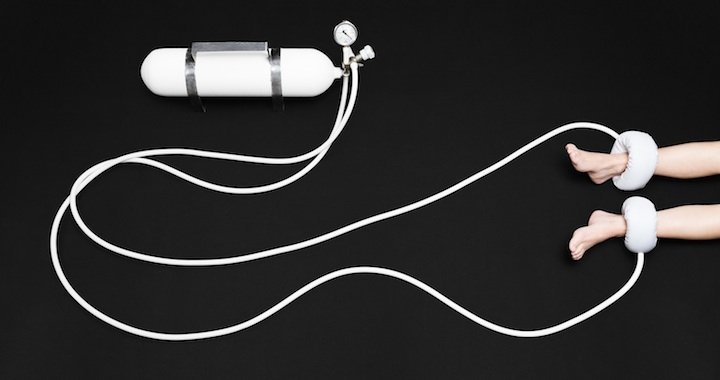
A Self-Made Dream Scenario
Julijonas Urbonas’ dream hotel, “Oneiric Hotel”
02/12/2015
Levitation, gravitational dreams, lucid dreaming – these are the things that have been occupying the mind of Lithuanian artist and engineer Julijonas Urbonas for the last few years. His interest in the world of dreams drifts somewhere between science/facts and imagination/fiction. Having done substantial academic studies, he turned to creative experimentation, inviting volunteers to fall asleep and experience a new way of dreaming in the capsules he had constructed with special observational equipment.
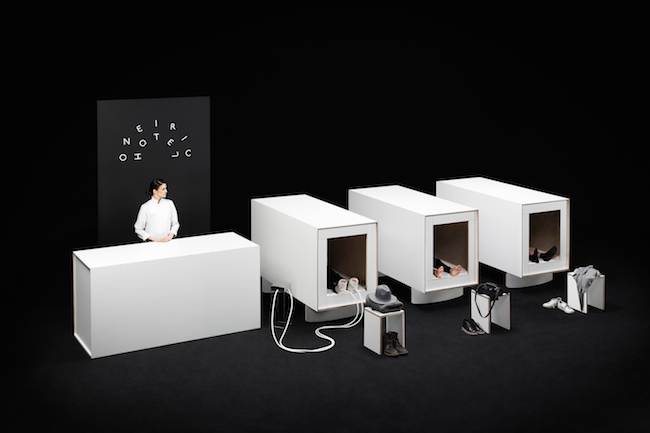
Oneiric Hotel. Photo: Aistė Valiūtė and Daumantas Plechavičius
As a foundational basis for this work, you looked at experiments that had been done in the 20th century. What was it that seemed interesting to you in these earlier studies and experiments on dreams? Was your intention to develop these experiments further, or to show them in a different light?
First of all, note that I did not focus on a particular period in history. It just happens to be that the majority of scientific experiments I am referring to are from the 20th century, but my research spans from as early as 1000 BCE (e.g., the Hindu Upanishads on lucid dreaming) to nowadays (e.g., various miniaturized and ‘domesticated' sleep lab devices, such as the ZEO Sleep Manager).
At some point in my PhD research, which I did at the Royal College of Art, I was investigating various experiential forms of levitation, including imagined and dreamed ones. In terms of the latter, I was especially interested in the so-called ‘gravitational dreams’ that feature gravitational activities such as flying, levitating, climbing, falling, feeling heavy, etc. Once I started to look into the history of dream science, it turned out that there were quite a few experiments that managed to induce such dreams. All of a sudden, I found these experiments rather peculiar and poetic in the way that they mingled design, technologies and scientific theatricals.
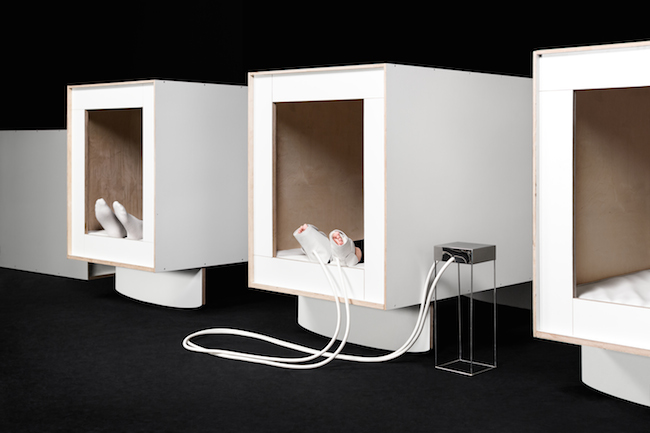
Oneiric Hotel. Photo: Aistė Valiūtė and Daumantas Plechavičius
First, I wanted to reconstruct these experiments in my own bedroom; after I had been doing this for a while, I had built up an urge to share my findings and experiences with the public. Before all of this, I was very skeptical about such practices, but my own bedroom experiments made me seriously reconsider. After a few months of combining various lo-fi model dream devices with psychological techniques, not only had I started to direct my dreams, but I could also wake up in my dreams, which is also known as lucid dreaming. That is why I wanted to turn these findings into a participative and open-to-direct-experience project, rather than just showing it as an exhibit on a pedestal. In other words, I wanted to catapult selected dream experiments out from the science labs and into a public space, one that would be open for wider and wilder forms of experimentation.
However, the project's aim is not a rigorous reconstruction of scientific dream experiments, but more of a poetic and open-ended interpretation of the act of dreaming. I am interested in merging the scientific and the factual with the imaginative and the fictional. With this project, I want people to literally feel what it is like to direct dreams, but also, and no less importantly, to broaden their understanding of this practice by allowing them to imagine alternative methods of such a practice. Therefore, I see the Oneiric Hotel as a participative theater in which people physically take part by creating their own roles, scripting their own scenarios, and playing lucid-dream make-believe. That is why you'll find fully-functioning medical devices and scenography working in tandem in this project.
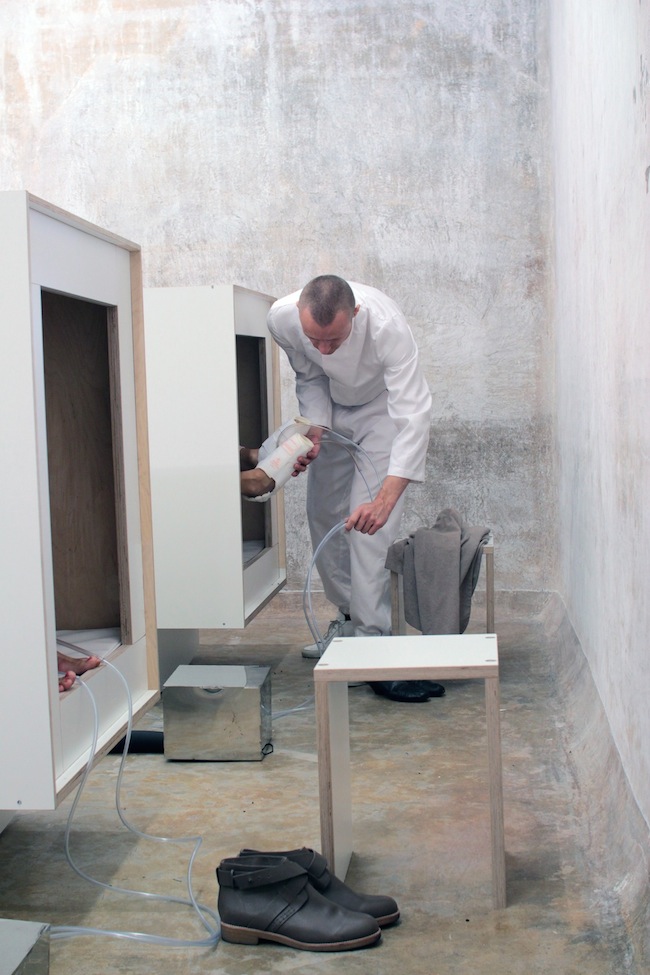
Installation view of Oneiric Hotel. Lisbon Architecture Triennale 2013. Photo: Nelson Rodrigues
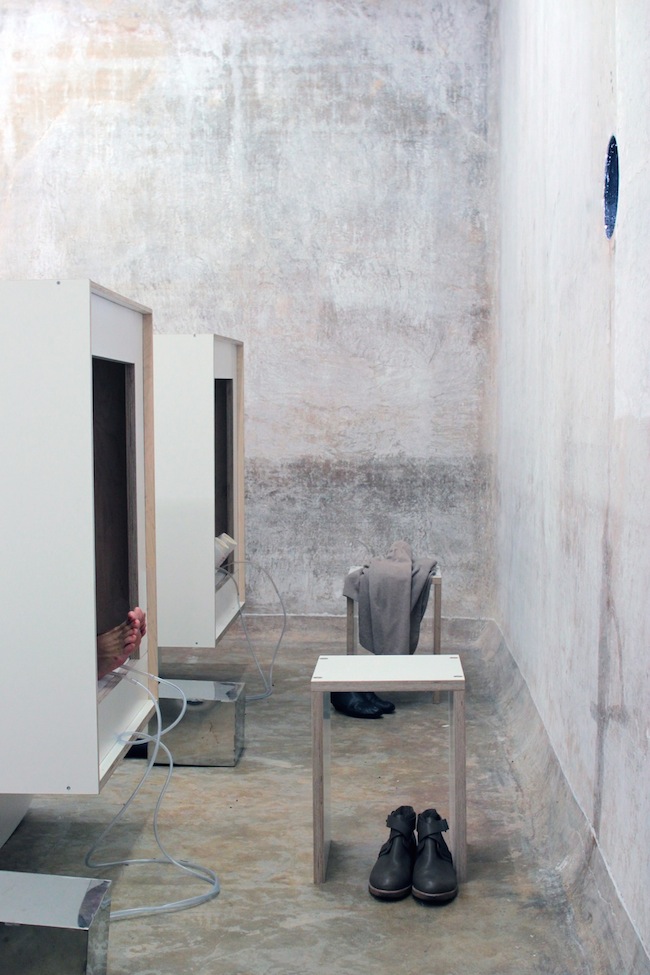
How long did it take to make this project? What was the biggest challenge?
First, the project started out as a survey of the contextual background and history of the practice of dream directing. For several months I obsessively collected and read various academic papers, patents and philosophical texts on dreams. Later on, I started singling out the most cited and supposedly most successful experiments, which I then reconstructed as lo-fi models for testing in my own bedroom. This continued sporadically for over a year, until I received an invitation to take part in the 2013 Lisbon Architecture Triennale. Showing these bedroom prototypes, I thought, would not make sense as the experience they produce is totally incomparable with their appearance. So I decided to turn the equipment into a sleepover experience, a temporary hotel where everybody could come take a nap and try the dream experiments on themselves. It was quite challenging as we (my team and I) had to deal with the requirements and infrastructure of an almost fully-functioning hotel: WC facilities, safety systems, bedlinen hygiene, privacy, a booking system, etc., especially considering the unusual venue – a large concrete cube on top of what used to be a water tower. We installed a reception desk and three sleep capsules equipped with special dream-directing equipment, which, by the way, was different every time we set it up. I’d either add or remove something to echo the subject of the exhibition that the project was a part of, or simply to try out new formats of the project. For example, the current version of the Oneiric Hotel features a specially-built rocking mechanism that rocks the sleep capsule once the sleeper falls into a dream state. Since the exhibition’s topic is levitation (Gallery Q 21, Vienna), I picked a dream experiment which, reportedly, successfully induced various flying and floating activities in the dreams of the sleep-subject. More specifically, it was the dream scientists’ Leslie & Ogilvie’s series of experiments with people sleeping in swinging hammocks. So, one could say that the project is ever-evolving.
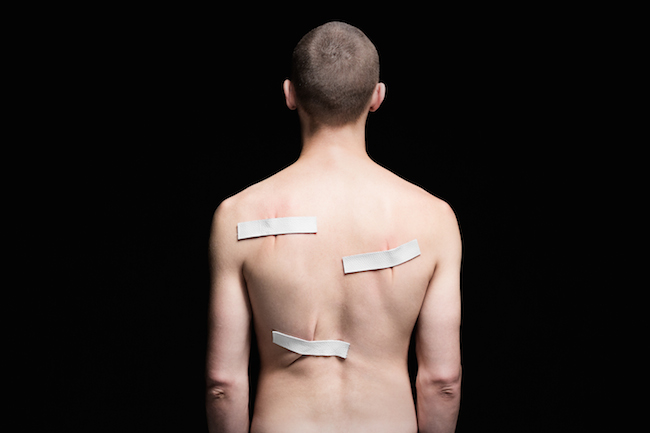
Oneiric Hotel. Cubberly’s Gummed Squares. Photo: Aistė Valiūtė and Daumantas Plechavičius
Could you explain to our readers, in non-scientific language, how all of this works?
You book a time and date for a sleep session at the Oneiric Hotel. Once you're there, before lying down in the capsule, you are introduced to the project's scientific and artistic background. Then, while hooked up with special sleep-monitoring equipment (a wireless EEG AKA Electroencephalograph), you are briefly instructed in a few psychological techniques of dream directing and lucid dreaming. When you fall asleep, the equipment looks into the special patterns of your brain activity and your eye movements to see which sleep-stage you are in. It basically waits for REM (Rapid Eye Movement), during which we dream the most. Under this stage of sleep, the sleep monitor turns on a particular stimulation device – for example, the aforementioned rocking motor – for the sleep capsule. You dream, and the capsule starts to rock. The longer you dream, the more intense the movements become until they wake you up (waking up during the dreaming state helps to better recall dreams). The stimulation device has two functions: it facilitates the direction of the dreams, and it can serve as an alarm for waking you up while you're either in a dream or out of it.
Here's a selected list of other stimulation devices:
The Castaldo and Holtzman Voice Player — a device that plays a prerecorded story in the voice of the dreamer. In 1967 the scientists Castaldo and Holtzman found that when the dreamer listened to his or her own voice while asleep, he or she reported that the main character in the dream was more active, assertive, and independent, compared with when the dreamer heard someone else’s voice; the latter led the main dream character to be more passive.
Nielsens’ Air Cuffs — A set of pneumatic pressure cuffs to be worn on the lower part of the legs. During the dreaming state, the cuffs rhythmically squeeze the calf and feet. They have two functions: to direct gravitational activities in the dream state, and to also induce an awareness of being in the dream state (it works a bit like a "reality-check" device). Dr Tore Nielsen employed the contraption on his sleep-subjects in scientific experiments conducted in 1993.
Cubberly’s Gummed Squares — a number of small pieces of adhesive tape, to be stuck on the bare skin in a scattered pattern throughout the body. In 1922 , Dr. A. J. Cubberley used the gummed squares to produce constant tensile stimulation of the skin throughout the night. He reported effects on dream content in 95% of the stimulation trials.
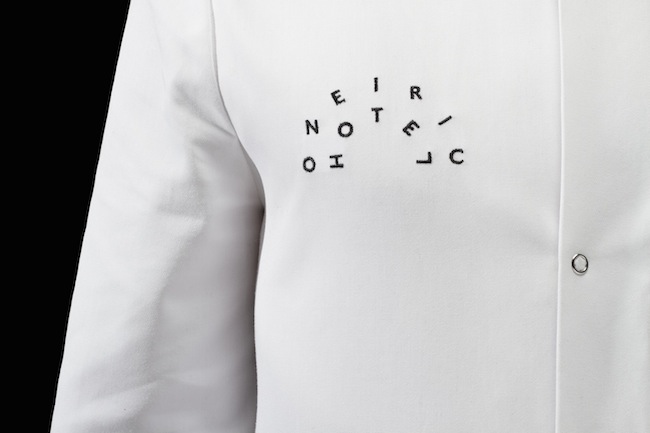
The detail of the costume that was specially tailored for the project by Aiste Nesterovaite. Logo design by Povilas Utovka. Photo: Aistė Valiūtė and Daumantas Plechavičius
Please tell us more about design of the Oneiric Hotel. How the were the capsules and other experiments constructed?
The design of the project was largely influenced by the initial budget and the deadline, both of which were scarce. Also, the project had to be easy to transport and install. After considering various options, such as inflatable structures, plush-like objects, etc., I chose white melamine plywood as the major material because my team and I have had extensive experience working with this material. Also, this made it look clean, hygienic and medical in nature. Once I started to draft the structures, I quickly submitted to the material, and it started to dictate its own laconic, constructivist aesthetics. The same went for the capsules, the reception desk, the chairs, the enclosures of the devices, and the transportation-storage boxes. Referring to the design of medical equipment, for the stimulation devices I also used medical-grade rubber, stainless steel, and leather.
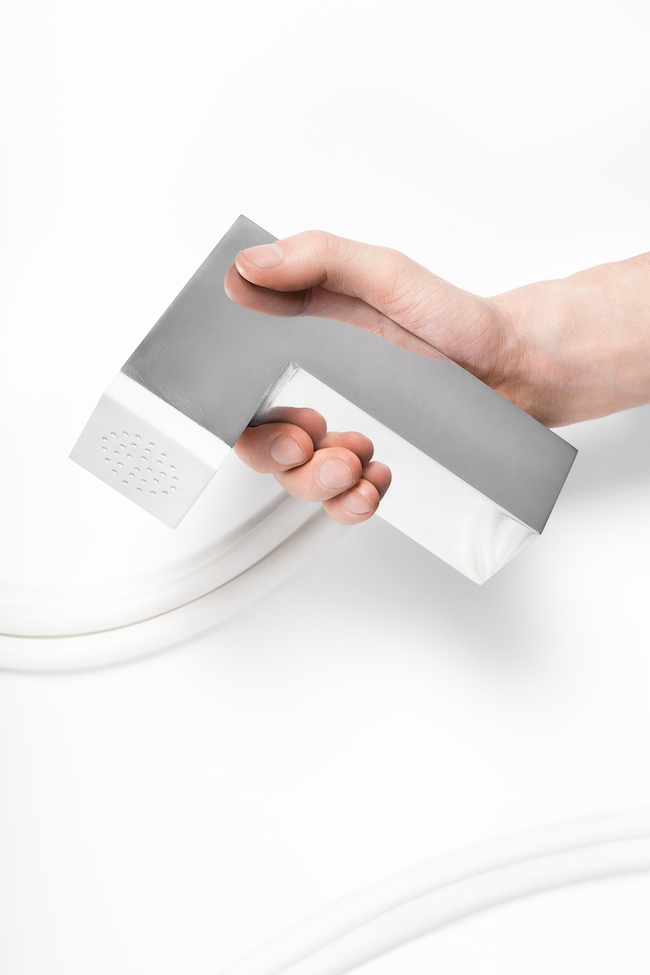
Voice recorder. Photo: Aistė Valiūtė and Daumantas Plechavičius
However, the design went much beyond the shapes of the capsules and the contraptions. As I mentioned before, I was particularly interested in the dialogue between the factual and the imagined. Therefore, I took my time to consider each detail of the project: the online ads, the press kits, the way people climb up to the hotel, the interior, the way the receptionists look and talk, the scent of the capsule, the micro-climate, etc. All of which create a unique experience and could be considered as important as the device that levitates you in your dream. All of this could be seen as a dream-directing placebo, which actually turned out to be very successful (I'll cover this a bit more later). That is why you find a special coverall designed by the Lithuanian designer Aistė Nesterovaitė (Formuniform), a logo by Povilas Utovka, and so on.
Your work has been exhibited internationally. How open are people to such experiences? Aren’t they afraid?
The project’s audience is very diverse in terms of motivation and reception. Some come in order to learn more about the dreaming practice, some want to be part of an art project, some seek therapeutic benefits, and some just want to take a nap… There is no single way to experience the hotel, and it is up to the public to come up with their own way of conducting their dream experiments.
What has been the most striking dream experience so far?
For me, it was not really a dream, but rather the late discovery of a malfunctioning of one the stimulation devices – although it had actually never really worked before, it had been used by sleep-subjects with the same success rate as if it had been functioning. This had a huge effect on the later development of the project. I delved into more extensive research on the placebo effect, and I started to consider the whole project as a complex placebo that incorporated everything – human and nonhuman, physical and virtual, tangible and not – that was somehow related to the Oneiric Hotel.

Nielsens’ Air Cuffs. Photo: Aistė Valiūtė and Daumantas Plechavičius
In one of the latest versions, in Klaipeda, Lithuania, I asked for a window gallery so that I would have a more non-target audience. Passersby would peer through the windows and wander in, thereby becoming accidental ‘experimental subjects’. These were mostly women in their 60s who actually did not manage to fall asleep in the capsules. But the most interesting thing was that two of them came back later and went straight up to me; their faces looked somewhat different – surprised, and they enthusiastically told me how they had experienced lucid dreams back at home, in their own beds. I could not help but conclude that the Oneiric Hotel was not bound to just its physical manifestation!
However, the rate of dream reports was not that great – only around two people in ten reported having had a lucid dream. But more than half of our sleepers told us that they had vivid dreams. Most of those who were woken up by the stimulation devices or external stimuli during REM were enthusiastic in reporting their dreams. Some of the dreams were quite extraordinary. For example, one electrical engineer had a non-lucid dream that was so otherworldly that he struggled putting it into words. In the dream, he had taken on the shape of something like an electron that was moving along in a kind of electronic circuit. What was most striking for him was that he felt that he had acquired a non-human sense of perception – that of an electron. He moved (extremely fast, at that!), felt and behaved as if he were an elementary particle. Another quite extraordinary dream was had by a woman who had come in believing that learning such a practice might help her deal with her fear of deep water. In her dream, she stood in front of an empty river and felt the ground trembling beneath her feet. The vibration kept increasing until she noticed something flowing down the river bed – it turned out to be a flowing and waving pile of naked human bodies. She soon joined the human wave.
Other people reported various dreams with quite diverse topics and scenarios. There were gravitational dreams, some dreams with sex activities, and a few with bizarre bodily deformations. Quite a few told us that some elements, from either the Oneiric Hotel or the stimulation devices, were incorporated in their dreams.
What do dreams mean to you personally?
Sometimes it is an entertainment platform on which I model otherworldly ways of having a good time; sometimes it is my sandbox, sketchbook, or prototype-reality where I can test out my project ideas, or even come up with new ones. But most often, I just switch to a passive mode and allow myself to soar on the bizarre imagery…
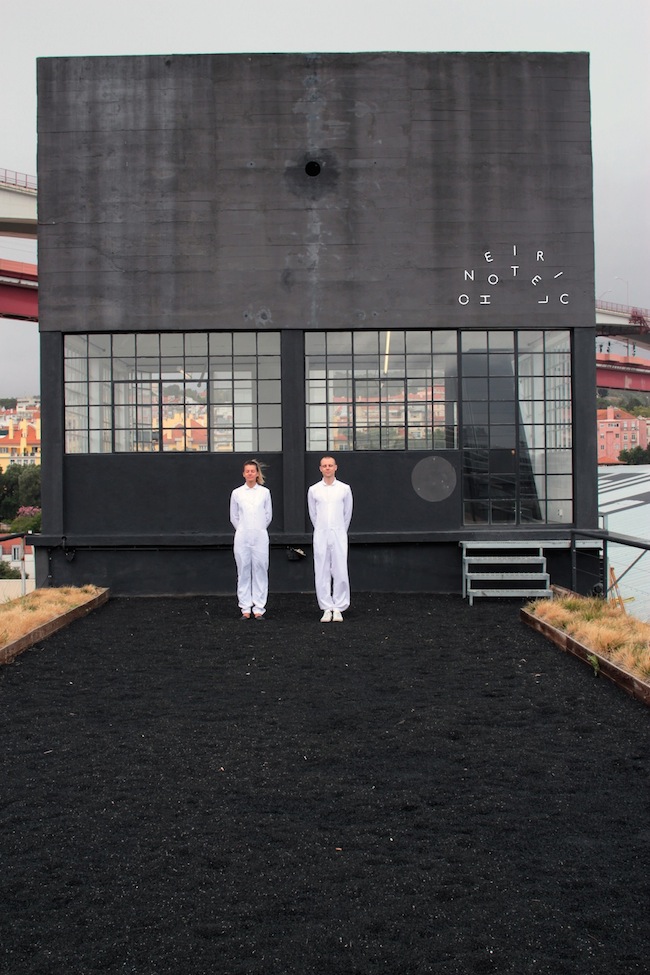
Julijonas Urbonas and Justė Kostikovaitė in front of the water ter where Oneiric Hotel was based. Photo: Nelson Rodrigues
What are your plans for the future regarding the “Oneiric Hotel”? Where and when will people have the opportunity to discover and experience your work?
I’m planning to put this project on hiatus for a while as there are a few other, quite complex projects that I want to fully devote myself to. So, there are no near-future plans for the Oneiric Hotel. Maybe somebody will show interest in taking it over and transferring it into a real, long-term hotel…